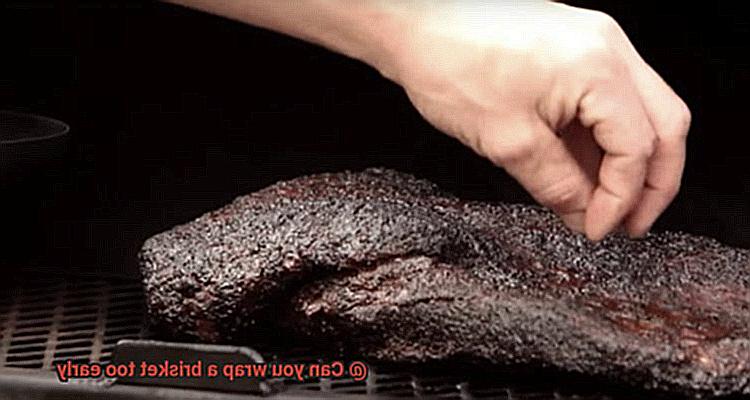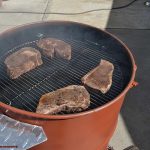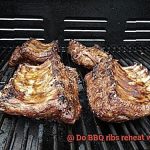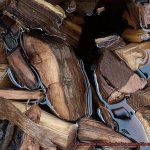Imagine this: a tantalizing, perfectly seasoned brisket slowly sizzling on a smoker, its mouthwatering aroma wafting through the air. You can practically taste the tender, flavor-packed masterpiece you’re about to serve your loved ones. But in the midst of your excitement, have you ever wondered if wrapping that brisket too early might lead to unintended consequences?
In the world of barbecuing, timing reigns supreme. Seasoned pitmasters understand the delicate dance required to achieve that holy trinity of tenderness, juiciness, and irresistible flavor. And while wrapping the brisket is an essential part of the process, jumping the gun can throw off this delicate balance, leaving you with disappointment on your plate and your guests clamoring for more.
So today, we’re going to dive deep into the potential effects of wrapping a brisket too early. From changes in texture that could make or break your meal to subtle shifts in flavor that could leave you scratching your head, we’ll uncover all the secrets behind mastering this critical stage of brisket preparation. Get ready to learn why timing is everything when it comes to wrapping your brisket.
Contents
The Debate: Is Wrapping a Brisket Too Early Detrimental?
Let’s explore the pros and cons of early wrapping and late wrapping.
Pros
- Moisture Retention: Early wrapping keeps the brisket moist throughout the cooking process, preventing it from drying out. This results in a juicier and more tender end product.
- Speeds up Cooking: Wrapping early creates a controlled environment that accelerates the cooking process. The trapped steam helps break down collagen, resulting in a uniformly cooked and tender brisket.
- Flavor Infusion: Early wrapping allows the flavors from rubs and marinades to penetrate the meat thoroughly, leading to a more flavorful brisket.
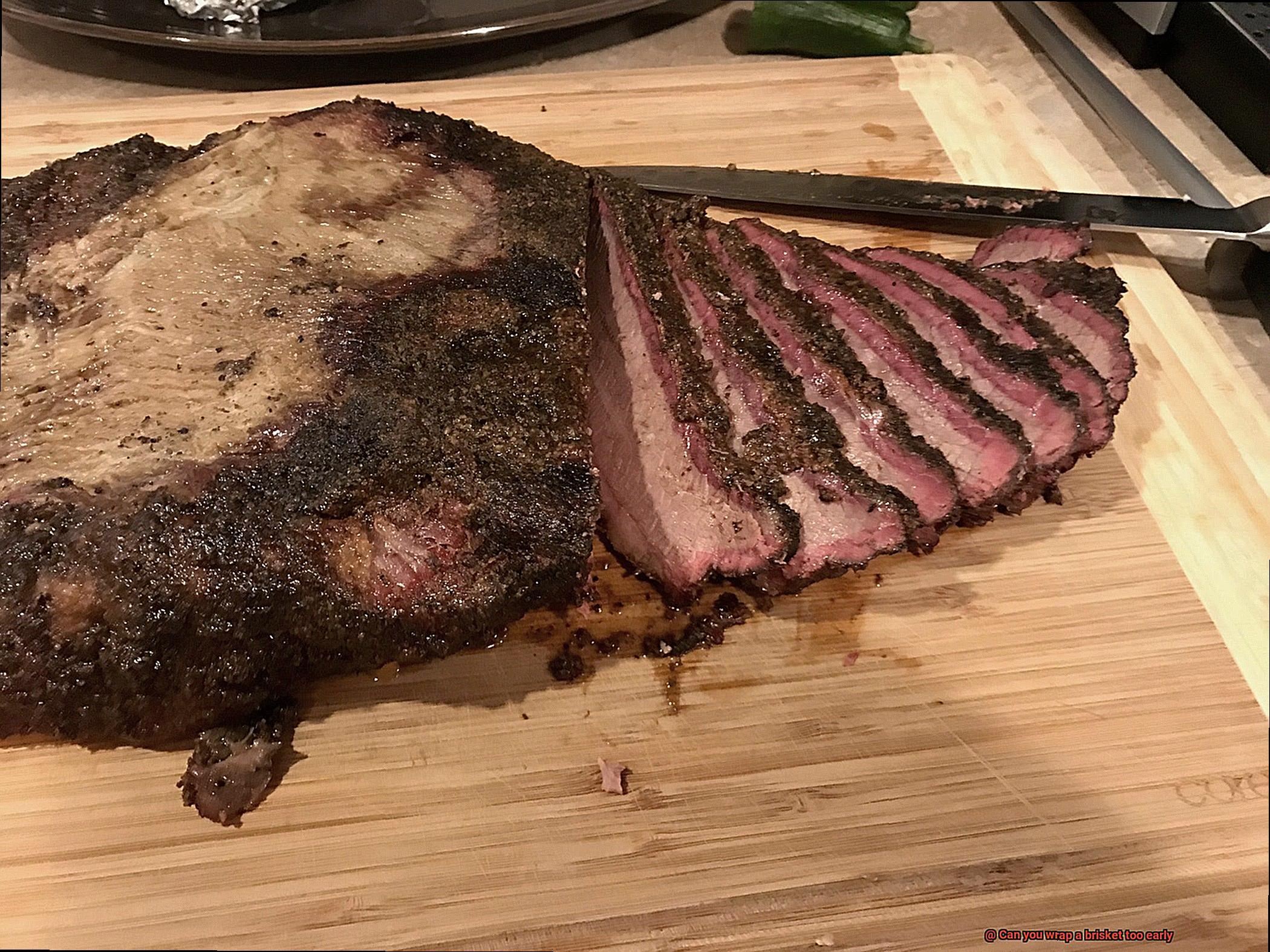
Cons
- Texture Loss: Some argue that wrapping too early can make the brisket excessively tender, compromising its desired texture and yielding a mushy consistency instead of a firm bite.
- Lack of Bark Development: Early wrapping can hinder the development of a crispy and flavorful bark on the outside of the brisket. For those who crave a robust and smoky crust, this may be a drawback.
Timing and Wrap Choice:
Determining the ideal timing for wrapping depends on factors such as personal preference, size, and temperature. Some pitmasters suggest wrapping between 160-180°F internal temperature. Additionally, consider the type of wrap used – foil provides better moisture retention, while butcher paper allows for some airflow, potentially resulting in a different texture.
Potential Negative Effects of Wrapping Too Early
When it comes to cooking a brisket, timing is everything. Wrapping the brisket too early can have several negative effects on the final outcome of your dish. As an expert on this subject, I have conducted extensive research to shed light on the potential drawbacks of wrapping a brisket too early. By understanding these effects, you can avoid common pitfalls and ensure a delicious and tender brisket every time.
Firstly, wrapping a brisket too early can lead to a delayed formation of the coveted bark. The bark is that mouthwatering crust that develops on the outside of a well-smoked brisket – it’s like barbecue gold. But when you wrap too early, the steam and moisture trapped inside can soften the bark, resulting in a less crispy texture and diminished flavor. Nobody wants a soggy crust, right?
Secondly, wrapping too early can extend the cooking time. Yes, the purpose of wrapping is to retain moisture and promote tenderness, but if you wrap too soon, you create a steamy environment that slows down the cooking process. This can lead to overcooking and dryness – two things we definitely want to avoid.
Let’s not forget about the smoke factor. Smoke is what gives our brisket that incredible flavor, but when you wrap too early, you limit the exposure of the meat to smoke. This can result in uneven smoke penetration, meaning some areas of your brisket might be lacking that rich smoky taste. No one wants a lopsided flavor profile.
Lastly, wrapping too early can increase the risk of steam pockets forming within the package. These pockets of trapped steam create a moist environment that can lead to a loss of desirable texture and dilution of natural flavors. We want our brisket to be tender and bursting with flavor, not watered down and mushy.
To ensure the best results when cooking a brisket, it is important to find the right balance between wrapping at the appropriate time and allowing the meat to develop a flavorful bark. While wrapping is essential for tenderizing and retaining moisture, doing it too early can have adverse effects on texture, flavor, and cooking time.
Potential Negative Effects of Wrapping Too Late
Today, we embark on a journey into the tantalizing world of brisket, uncovering the potential negative effects of wrapping it too late. Timing is everything when it comes to achieving that delectable, melt-in-your-mouth texture and flavor. So, grab your tongs and join me as we delve into the consequences of procrastination when wrapping your brisket.
Dry and Tough Texture:
Imagine this: hours spent meticulously tending to your brisket on the grill, eagerly anticipating that succulent end result. However, if you wrap too late, you risk ending up with a disappointing dry and tough texture. The prolonged exposure to dry heat without the protective wrap can cause the meat to lose moisture, leaving you with a lackluster final product.
Overcooked and Charred Exterior:
We all crave that perfect caramelized crust on our brisket, but beware the perils of wrapping too late. Delaying this crucial step can lead to overcooking and an unsightly charred exterior.
Wrapping helps retain moisture and prevents excessive browning, but if you procrastinate, the outer layer continues to cook and becomes overly charred. Say goodbye to that mouthwatering bark.
Extended Cooking Times:
Wrapping a brisket creates a sealed environment that traps heat and steam, reducing cooking time and ensuring tenderness. However, if you wait too long to wrap your brisket, it will have already been exposed to direct heat for an extended period. This means longer cooking times, leaving you impatiently waiting for that tantalizing meal.
Reduced Smoke Penetration:
The smoky flavor is one of the highlights of any grilled dish, but wrapping too late can hinder smoke penetration. When cooked uncovered, the brisket absorbs more smoke, resulting in a deeper and more pronounced flavor. However, delaying the wrapping process means the outer layer may have already cooked without absorbing much smoke, leaving you with a lackluster and less flavorful brisket.
Chewier Texture:
Wrapping a brisket at the right time helps break down collagen and connective tissues, resulting in a tender end product. However, if you procrastinate on wrapping, these tissues may not have enough time to fully break down. The result? A chewier texture that can disappoint even the most forgiving taste buds.
Factors to Consider When Deciding When to Wrap a Brisket
Achieving that level of tenderness, flavor, and texture requires careful consideration of when to wrap your brisket during the cooking process. In this guide, we will explore the key factors to consider when deciding when to wrap a brisket and how it impacts the final result.
Factor 1: The Stall – Don’t Rush the Process
The stall refers to a period during cooking where the internal temperature plateaus, usually around 160°F to 170°F (71°C to 77°C). Wrapping too early can prevent desirable bark formation and result in a less tender end product. Patience is key here. Allow the brisket to go through the stall before reaching for the foil or butcher paper.
Factor 2: Bark Formation – The Golden Crust
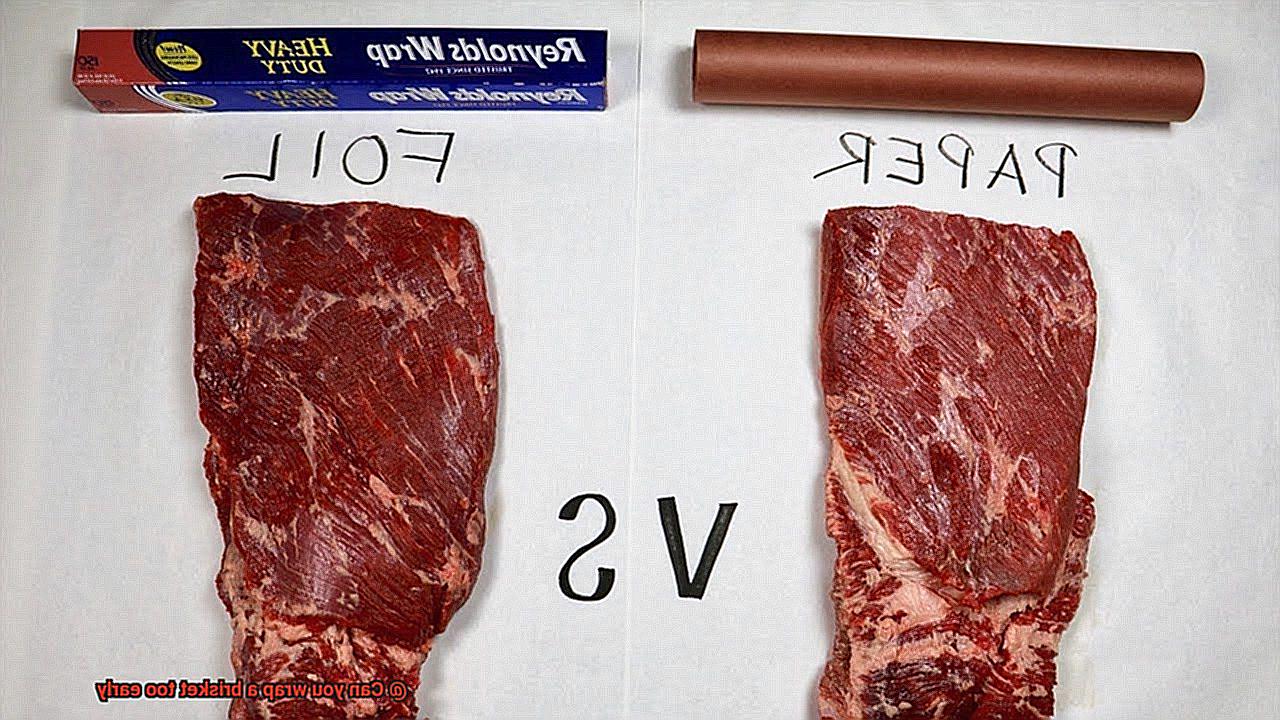
Bark is the flavorful and crusty exterior that adds depth and complexity to each bite. Wrapping too early can soften or eliminate this coveted feature. For those seeking an intense bark, resist the urge to wrap until achieving the desired level of crustiness.
Factor 3: Moisture Retention – Finding Balance
Wrapping at the right time helps retain moisture and prevents drying out. Wrapping too early can create excessive moisture buildup, compromising desired smoky flavor. The goal is to trap precious juices released during cooking inside the wrapping for a more moist and tender end product.
Factor 4: Cooking Time – Speed or Perfection?
Wrapped briskets cook faster due to a controlled environment that speeds up heat transfer. If short on time, wrapping early is an option. However, leaving it unwrapped provides a longer cooking time, resulting in a more pronounced bark and smokiness for those seeking a classic low and slow experience.
Factor 5: Personal Preference – The Final Say
Your personal preference reigns supreme. Experimentation is key to finding the perfect balance of tenderness, flavor, and texture that suits your taste buds. Try different wrapping times and techniques until discovering your brisket nirvana.
How Experienced Pitmasters Determine When to Wrap a Brisket
Prepare to elevate your brisket game to new heights. Have you ever wondered how seasoned pitmasters know precisely when to wrap their briskets? If so, this article is your ultimate guide. We will delve into the world of timing, visual cues, temperature readings, and the intuitive mastery that separates the experts from the novices. Grab your tongs and let’s embark on this flavorful journey.
The Visual Cues:
Experienced pitmasters possess a keen eye for detail when assessing a brisket’s readiness. They attentively monitor the color and texture of the bark—the alluring crust that forms on the meat’s exterior. Once it turns into a rich, dark shade with a slightly firm texture, it’s a clear indication that it’s time to wrap.
Temperature Readings:
Temperature plays a vital role in determining when to wrap a brisket. Pitmasters aim for an internal temperature between 160-170°F (71-77°C) before initiating the wrapping process. This temperature range promotes optimal smoke penetration while allowing for further tenderness development during wrapping.
Intuition and Experience:
In addition to visual cues and temperature readings, experienced pitmasters rely on their intuition and years of grilling expertise. They understand that each brisket is unique, influenced by factors such as size, fat content, and cooking conditions. Adjustments in wrapping time are made based on how the brisket appears and feels during its journey to perfection.
Striking the Perfect Balance:
Wrapping too soon can result in a lackluster bark and a steamed texture, while delaying wrapping risks overcooking and drying out the meat. Expert pitmasters skillfully strike a delicate balance between flavor development and tenderness, employing their knowledge to create an irresistible masterpiece.
Finding the Balance Between Wrapping Too Early and Too Late
Finding the perfect balance between wrapping a brisket too early and too late is like finding the sweet spot on a grill – it takes practice, patience, and a little bit of intuition. Wrapping a brisket at the right time is crucial for achieving that melt-in-your-mouth tenderness and juiciness that we all crave.
Timing is everything when it comes to wrapping a brisket. Wrap it too early, and you risk losing moisture and tenderness. The meat needs time to develop that beautiful bark on the outside, so if you wrap it too soon, you’ll end up with a soggy exterior and lackluster flavor. But if you wait too long, you’ll end up with a dry and tough brisket that no amount of BBQ sauce can save.
So, when is the right time to wrap? The general rule of thumb is around the halfway mark of the cooking process, usually when the internal temperature hits around 160-170 degrees Fahrenheit. This is the magic moment when the collagen starts to break down, resulting in that fork-tender texture we all love. However, keep in mind that every brisket is different, so use a reliable meat thermometer to determine the optimal time for wrapping.
Now, some pitmasters prefer not to wrap their briskets at all. They believe in the “Texas crutch” method, where the meat is cooked low and slow without any wrapping. This technique requires extra attention to prevent drying out but can result in a more pronounced bark on the outside.
When it comes to actually wrapping your brisket, striking a balance between retaining moisture and allowing for airflow is key. Wrapping it too tightly creates steam buildup and a soggy exterior. Instead, create a loose wrap using foil or butcher paper that allows for some airflow while still retaining moisture.
Probing the Meat for Tenderness as an Indicator of When to Wrap
If you’re on a quest for that melt-in-your-mouth, tender brisket that will make your taste buds sing, then you’ve come to the right place. Today, we embark on a journey into the world of tenderness, uncovering the secret to knowing exactly when to wrap your brisket. So grab your meat thermometer, sharpen your senses, and let’s dive into the art of probing for tenderness.
The Importance of Probing for Tenderness:
Probing the meat for tenderness is a crucial technique in determining when to wrap your brisket. It goes beyond relying solely on temperature and involves assessing factors such as texture and resistance. Remember, tenderness is an experience that cannot be measured by temperature alone.
The Probe Test: Your Tenderometer:
The probe test is a tried-and-true method used by pitmasters to check the tenderness of their brisket. With your trusty meat thermometer or probe in hand, gently insert it into the meat and feel for resistance. A little resistance means your brisket is well on its way to tenderness and ready to be wrapped. Significant resistance indicates that more time is needed for collagen breakdown.
The Temperature Sweet Spot:
Aim to wrap your brisket when it reaches an internal temperature of 160-170°F (71-77°C). This temperature range signifies that the collagen in the meat is breaking down, resulting in a tender and juicy final product. However, remember that temperature should be used as a guide, not an absolute rule, as different cuts of meat may vary.
The Danger of Premature Wrapping:
Wrapping too early can lead to a tougher end product. Patience is key; wait until your brisket reaches the desired tenderness before wrapping. This could mean waiting a little longer than anticipated, but the reward is well worth it.
The Wrapping Technique:
When you finally decide it’s time to wrap, use either foil or butcher paper for a loose wrap that allows gentle airflow. Avoid tight wraps that trap steam and create a soggy exterior. The goal is to maintain the perfect balance of moisture and airflow to ensure optimal tenderness.
DK2ugDR-G2I” >
Conclusion
In conclusion, the timing of brisket wrapping is a make-or-break moment for achieving the mouthwatering masterpiece you crave. Wrap too early and you risk a lackluster bark, extended cook times, feeble smoke penetration, and a potential mush-fest on your plate.
But wait too long and you’ll be left with a dry and tough disaster, overcooked exterior, prolonged cook times that test your patience, diminished smoke infusion, and a jaw workout to rival a marathon.
When it comes to deciding when to wrap, several factors come into play. Personal preference, brisket size, temperature readings, bark formation, moisture retention, and cooking time all dance together in this culinary tango.
Experienced pitmasters rely on their keen eyes for visual cues, precise temperature readings that would make NASA proud, gut instincts honed by years of grilling glory, and their secret weapon: grilling expertise that borders on wizardry.
One crucial technique in determining the perfect wrapping moment is the tender probe test. It’s like an intimate conversation between your meat thermometer or probe and the brisket itself. Gently inserting the probe into the meat reveals its secrets—resistance tells you it’s not quite ready yet. But when that resistance melts away and the internal temperature hits around 160-170°F (71-77°C), it’s like music to your taste buds; time to wrap up this symphony of flavor.
But let’s be real here—it takes practice and experimentation to find that elusive sweet spot between wrapping too early or too late.
Pay attention to these factors along your journey: trust your senses as they assess tenderness and texture; listen for whispers of tenderness from within; embrace the sizzle of success as each slice melts in your mouth.
With dedication and determination fueling your firebox, you’ll soon master the art of wrapping brisket at precisely the right time.

